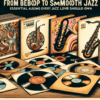Miles Ahead: The Provocative Life and Lasting Legacy of Miles Davis

Miles Davis was not just a musician; he was a revolutionary figure in jazz and popular music whose impact reached far beyond the confines of traditional genres. From the cool jazz of the late 1940s to the advent of jazz fusion, Miles' career was marked by constant innovation and a bold refusal to conform. His life was as tumultuous as the music he made, filled with personal struggles, artistic challenges, and a relentless drive for perfection. This article will delve into the provocative life and lasting legacy of Miles Davis, exploring how he transformed the musical landscape and influenced generations of artists.
Early Years and Musical Genesis
Miles Dewey Davis was born on May 26, 1926, in Alton, Illinois, but grew up in East St. Louis, Missouri. From an early age, Davis showed a keen interest in music, particularly in the trumpet, which he began playing at age 13. His early influences included the great Louis Armstrong and the legendary jazz trumpeter Dizzy Gillespie, which would set the foundation for his own unique style.
By the time he reached his late teens, Davis had moved to New York City to study at the Juilliard School, but he soon dropped out to immerse himself in the vibrant jazz scene of Harlem. During this period, he found himself collaborating with other jazz icons such as Charlie Parker and Thelonious Monk. His debut album, "Miles Ahead," released in 1957, showcased his exceptional ability to interpret complex melodies and time signatures, establishing him as a leading figure in the modern jazz movement.
The Birth of Cool Jazz
See Also: Improvisation in Jazz: The Heartbeat of Musical Expression
Improvisation in Jazz: The Heartbeat of Musical ExpressionOne of Davis's significant contributions to music was the creation of "cool jazz," a lighter, more subdued style that contrasted sharply with the frenetic energy of bebop. This evolution was marked by his iconic album "Birth of the Cool," which featured a nonet in which he elegantly blended various musical influences. This project not only defined a new genre but also displayed Davis' knack for collaboration, bringing in talented arrangers like Gil Evans, who helped shape the sophisticated orchestral sound.
The "cool" aesthetic resonated with audiences, and as jazz became more popular, Davis remained at the forefront of this movement, not shying away from experimentation. His ability to blend modernist principles with traditional jazz forms was a hallmark of his style, and it laid the groundwork for future musical explorations.
A Troubled Genius
Despite his musical accomplishments, Davis's life was marked by struggles with addiction, personal loss, and turbulent relationships. His battle with substance abuse, particularly heroin and cocaine, deeply affected his career and health. In the 1970s, he faced a particularly low point, retreating from the public eye for nearly five years. However, Davis wasn't one to be defeated easily. His comeback in the late '70s introduced jazz fusion, a genre that melded jazz with rock and funk, signaling another artistic metamorphosis.
His 1970 album "Bitches Brew" was a watershed moment in music history. Pioneering this chaotic yet captivating sound, it laid the groundwork for countless musicians in various genres. In a sense, "Bitches Brew" embodied Davis's own complexities—the interplay between harmony and disarray, and the quest for self-understanding through art.
See Also: From Bebop to Smooth Jazz: Essential Albums Every Jazz Lover Should Own
From Bebop to Smooth Jazz: Essential Albums Every Jazz Lover Should OwnIconic Collaborations and Cultural Impact
Throughout his career, Davis worked with a range of musicians, many of whom would carry his legacy into the future. Legendary partnerships with artists like John Coltrane, Herbie Hancock, and Wayne Shorter not only pushed the boundaries of jazz but also expanded its audience. His collaborations showed an openness to divergent musical styles, which he felt were essential for artistic growth.
Davis was also aware of the cultural currents around him; he understood that his music could influence social change. Throughout the Civil Rights Movement, his work often reflected the struggles and aspirations of African Americans. His piece "So What" epitomized that connection to the zeitgeist, with its strong, assertive rhythms symbolizing a rising awareness and demand for equality.
The Later Years and Enduring Influence
In the final years of his life, Davis continued to break barriers. His 1986 release "Tutu," a collaboration with producer Marcus Miller, infused electronic elements with jazz, showcasing his adaptability and undying thirst for artistic evolution. Davis was often perceived as a polarizing figure, yet this duality is precisely what makes his legacy compelling. He inspired a generation of artists, from jazz musicians to rock stars, with his insistence on individuality and innovation.
Davis passed away on September 28, 1991, but his music lives on. His creative approach and aesthetic continue to inspire countless musicians, pushing them to explore the ambitious intersection of genre and style. The essence of what he created resonates through modern music today—whether it's the improvisational freedom in jazz or the experimentation in genres like hip-hop, rock, and electronic music.
See Also: Ella Fitzgerald: The First Lady of Song and Her Unforgettable Influence on Jazz
Ella Fitzgerald: The First Lady of Song and Her Unforgettable Influence on JazzConclusion: The Lasting Importance of Miles Ahead
Miles Davis's legacy is more than just his discography; it is one of fearless self-expression and relentless innovation. He was a visionary who broke molds while establishing new forms and styles, which pushed the boundaries of what music could be. His life story serves as an undying testament to the power of resilience, the importance of personal authenticity, and the transformative nature of art.
In understanding Davis’s contribution, we grasp the foundation of modern jazz while appreciating the broader cultural implications of his work—reminding us that music doesn't just reflect society; it shapes it. "Miles Ahead" is not just about a man; it embodies a movement that changed the sonic landscape forever.
FAQs
1. What type of music did Miles Davis primarily play?
Miles Davis primarily played jazz, but he explored a wide range of styles, including bebop, cool jazz, jazz fusion, and modal jazz.
See Also: John Coltrane: The Sound of Spiritual Awakening Through Jazz
John Coltrane: The Sound of Spiritual Awakening Through Jazz2. What were some of Miles Davis's most influential albums?
Some of his most influential albums include "Kind of Blue," "Bitches Brew," "Miles Ahead," and "Sketches of Spain."
3. What was the significance of "Bitches Brew"?
"Bitches Brew" is often credited as one of the first significant jazz fusion albums, blending jazz with rock and electric instruments, thus redefining the genre.
4. Did Miles Davis struggle with addiction?
Yes, Miles Davis struggled with addiction, particularly to heroin and cocaine, which affected various periods of his career.
See Also: The Genius of Miles Davis: The Greatest Jazz Musician of All Time
The Genius of Miles Davis: The Greatest Jazz Musician of All Time5. How did Miles Davis influence modern music?
Miles Davis' innovative approach to jazz and his blending of genres paved the way for countless musicians across various musical styles, impacting genres like rock, funk, and hip-hop.
If you want to know other articles similar to Miles Ahead: The Provocative Life and Lasting Legacy of Miles Davis you can visit the category Jazz.
